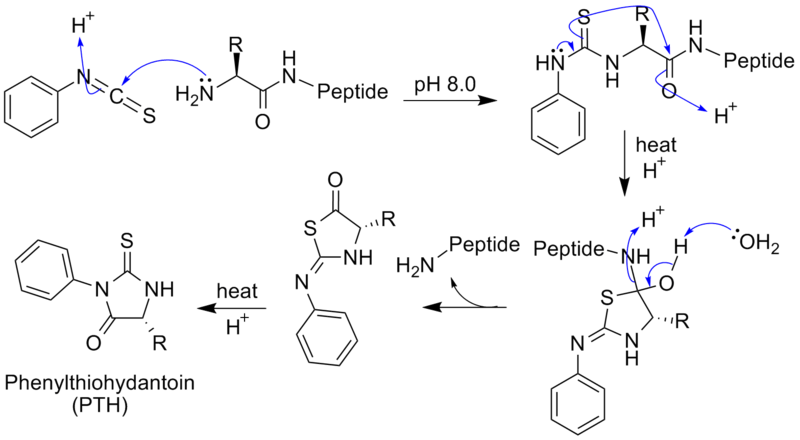


 علم الكيمياء
علم الكيمياء 
 الكيمياء التحليلية
الكيمياء التحليلية 
 الكيمياء الحياتية
الكيمياء الحياتية 
 الكيمياء العضوية
الكيمياء العضوية 
 الكيمياء الفيزيائية
الكيمياء الفيزيائية
 الكيمياء اللاعضوية
الكيمياء اللاعضوية 
 مواضيع اخرى في الكيمياء
مواضيع اخرى في الكيمياء
 الكيمياء الصناعية
الكيمياء الصناعية |
Read More
Date: 16-12-2019
Date: 16-12-2019
Date: 10-12-2019
|
Edman degradation is the process of purifying protein by sequentially removing one residue at a time from the amino end of a peptide. To solve the problem of damaging the protein by hydrolyzing conditions, Pehr Edman created a new way of labeling and cleaving the peptide. Edman thought of a way of removing only one residue at a time, which did not damage the overall sequencing. This was done by adding Phenyl isothiocyanate, which creates a phenylthiocarbamoyl derivative with the N-terminal. The N-terminal is then cleaved under less harsh acidic conditions, creating a cyclic compound of phenylthiohydantoin PTH-amino acid. This does not damage the protein and leaves two constituents of the peptide. This method can be repeated for the rest of the residues, separating one residue at a time.

Edman degradation is very useful because it does not damage the protein. This allows sequencing of the protein to be done in less time. Edman sequencing is done best if the composition of the amino acid is known. As we saw in Section 26.5, to determine the composition of the amino acid, the peptide must be hydrolyzed. This can be done by denaturing the protein and heating it and adding HCl for a long time. This causes the individual amino acids to be separated, and they can be separated by ion exchange chromatography. They are then dyed with ninhydrin and the amount of amino acid can be determined by the amount of optical absorbance. This way, the composition but not the sequence can be determined



|
|
|
|
دراسة يابانية لتقليل مخاطر أمراض المواليد منخفضي الوزن
|
|
|
|
|
|
|
اكتشاف أكبر مرجان في العالم قبالة سواحل جزر سليمان
|
|
|
|
|
|
|
المجمع العلمي ينظّم ندوة حوارية حول مفهوم العولمة الرقمية في بابل
|
|
|